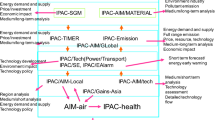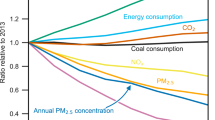Abstract
The technical roadmap and policies for CO2 mitigation suitable for China are a common center of attention in the fields of energy, environment, and management science in the country. Emphasizing interaction between technical research and policy research, this work discovers the potential breakthrough in the integrated field. The technical difficulties of recovering CO2 are pointed out, the mechanism of combining CO2 recovery with energy conversion is investigated, and the basic principle for integrating an environmental-friendly energy system is discussed. Moreover, the formulation of a new energy system that can recover CO2 with very low or even zero energy penalty is proposed, while the assessment methodology and model system for the technical roadmap of CO2 emission control are developed. Finally, a new technical roadmap constructing an energy network suitable for China is proposed, which may provide a new way for the development of sustainable energy and environment technologies.
Similar content being viewed by others
References
Intergovernmental Panel on Climate Change (IPCC). Climate Change 2007. Working Group I Report “The Physical Science Basis”. Cambridge: Cambridge University Press, 2007, http://ipcc-wg1.ucar.edu/wg1/wg1-report.html
Intergovernmental Panel on Climate Change (IPCC). Climate Change 2007. Working Group II Report “Impacts, Adaptation and Vulnerability”. Cambridge: Cambridge University Press, 2007, http://www.ipcc.ch/SPM13apr07.pdf
Intergovernmental Panel on Climate Change (IPCC). Climate Change 2007. Working Group III Report “Mitigation of Climate Change”. Cambridge: Cambridge University Press, 2007, http://www.ipcc.ch/SPM040507.pdf
He J K. Facing climate change under the sustainable development structure. Science Times (in Chinese). June 12, 2007
He J K, Zhang X L. Analysis of China’s energy consumption intensity reduction tendency during the 11th Five-Year-Plan Period. China Soft Sci (in Chinese). 2006, 4: 33–38
MOST, NSFC. Report of Development of Fundamental Research in China (in Chinese). Beijing: Science Press, 2001
Jin H G. Integration Principle for CO2 Emission Control, 100 Science Problems in Intersection Field of 21 Century (in Chinese). Beijing: Science Press, 2005. 173–179
Andersen T, Kvamsdal H M, Bolland O. Gas turbine combined cycle with CO2-capture using auto-thermal reforming of natural gas. Proceedings of ASME TURBO EXPO 2000, Munich, Germany, May 8–11, 2000
Chiesa P, Consonni S. Shift reactors and physical absorption for low-CO2 emission IGCCs. ASME Trans, J Eng Gas Turbines Power, 1999, 121: 295–305
Lozza G., Chiesa P. Natural gas decarbonization to reduce CO2 emission from combined cycles-part I: Partial oxidation. ASME Trans, J Eng Gas Turbines Power, 2002, 124: 82–88
Lozza G, Chiesa P. Natural gas decarbonization to reduce CO2 emission from combined cycles-part II: Steam-methane reforming. ASME Trans, J Eng Gas Turbines Power, 2002, 124: 89–95
Bolland O, Mathieu P. Comparison of two CO2 removal options in combined cycle power plants. Energy Convers Manage, 1998, 39(16–18): 1653–1663
Ishida M, Jin H G. A new advanced power generation system using chemical-looping combustion. Energy-The International Journal, 1994, 19: 415–422
Jin H G, Ishida M. A new advanced IGCC power plant with chemical-looping combustion. Proc. of TAIES’97, Beijing, China, pp. 548–553, 1997
Jin H G., Hong H, Wang B Q, et al, A new principle of synthetic cascade utilization of chemical energy and physical energy. Sci China Ser E-Tech Sci, 2005, 48(2): 163–179
Jin H G, Gao L, Lin R M. Polygeneration system with CO2 recovery. China Patent, Number: 200610003198.4
Jin H G, Gao L, Han W, et al. A new approach integrating CO2 capture into a coal-based polygeneration system of power and liquid fuel. Proceedings of ASME TURBO EXPO 2007, GT-2007-27678, Montreal, Canada, May 14–17, 2007
Jin H G, Han W, Gao L. Multifunction energy system (MES) with multifossil fuels and multiproducts. ASME Trans, J Eng Gas Turbines Power. 2007, 129: 331–337
Xu Y J, Jin H G, Lin R M, et al. System study on partial gasification combined cycle with CO2 recovery. ASME Trans, J Eng Gas Turbines Power, 2008, in press
Jin H G, Cai R X, Wang B Q. Development of Clean-Coal Technology, Urbanization, Energy, and Air Pollution in China, joint report between US National Academy of Sciences and Chinese Academy of Sciences. Washington D C: The National Academies Press, 2004. 237–249
Author information
Authors and Affiliations
Corresponding author
Additional information
Supported by the major international cooperation projects of the National Natural Science Foundation of China (Grant No. 50520140517)
Rights and permissions
About this article
Cite this article
Jin, H., Zhang, X., Gao, L. et al. Fundamental study of CO2 control technologies and policies in China. Sci. China Ser. E-Technol. Sci. 51, 857–870 (2008). https://doi.org/10.1007/s11431-008-0062-4
Received:
Accepted:
Published:
Issue Date:
DOI: https://doi.org/10.1007/s11431-008-0062-4




